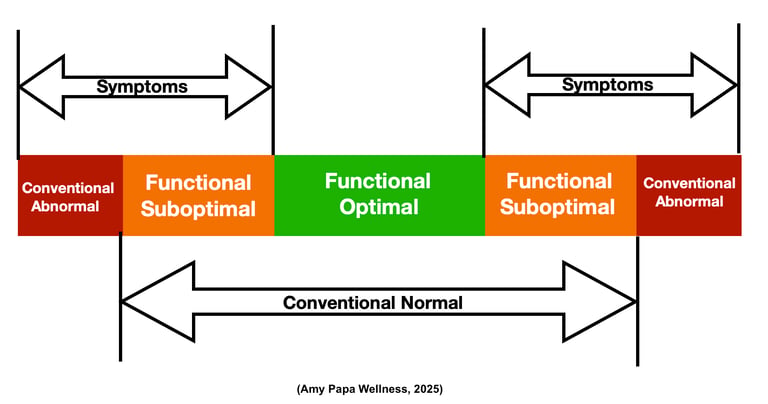Functional vs. Conventional


When it comes to assessing health through blood tests, conventional medicine and functional medicine approach reference ranges differently. Understanding these differences can help individuals gain deeper insights into their health and take proactive steps toward optimal wellness.
Conventional Medicine Blood Test Reference Range
In conventional medicine, blood test reference ranges are based on a statistical average of the population. These ranges represent the middle 95% of test results from a broad and diverse group of individuals. If a value falls within this range, it is considered "normal," whereas results outside the range may indicate a disease or medical condition requiring intervention.
However, conventional reference ranges have limitations:
They include both healthy and unhealthy individuals, potentially skewing the data.
They are often too broad, meaning someone could be within the “normal” range but still experience symptoms of imbalance.
They focus more on diagnosing disease states rather than identifying early dysfunction.
Functional Medicine Blood Test Reference Range
Functional medicine takes a more personalized approach to interpreting blood tests. Instead of relying solely on broad population averages, it defines an optimal range—a narrower reference range that represents the levels associated with optimal health and function rather than just the absence of disease.
Key features of functional medicine reference ranges:
Focus on prevention: Helps identify imbalances before they develop into full-blown diseases.
Narrower, more precise ranges: Aims for optimal function rather than just “not sick.”
Individualized approach: Takes into account a person’s unique biochemistry, lifestyle, and symptoms.
Functional vs. Conventional Reference Ranges
Below is a graph illustrating the difference between conventional and functional medicine reference ranges:




Copy right
Example: Vitamin D Levels
Conventional Reference Range: 20-100 ng/mL (Anything above 20 is often considered “normal.”)
Functional Medicine Optimal Range: 60-80 ng/mL (A range associated with optimal immune function and overall health.)
Someone with a Vitamin D level of 22 ng/mL would be considered “normal” in conventional medicine, but functional medicine would flag it as deficient.
Why This Matters
If you’ve ever been told your lab results are "normal" but still feel unwell, functional medicine’s approach may provide the missing piece to your health puzzle. By aiming for optimal levels rather than just “not abnormal,” you can take proactive steps toward improved energy, digestion, hormone balance, and overall well-being.
At Amy Papa Wellness, we offer a wide range of blood tests and advanced Functional Medicine testing. Click here to order a Vitamin D test for yourself now. We offer two types of Vitamin D tests: one is a blood draw done at LabCorp, and the other is a dried blood spot test (a finger-prick test), which is a more convenient option for children or those who prefer to avoid a traditional blood draw.
Vitamin D level is crucial for preventing various chronic illnesses, including cancer. However, it is not typically included in routine lab tests ordered by doctors, nor is it usually covered by insurance. Many doctors may even refuse to order it for you upon request. Save yourself the hassle—click here to order your own test, likely at a lower cost than going through your doctor.
If you want to gain a clear understanding of your current health status and identify areas for improvement to prevent chronic diseases, or if you've been to multiple doctors without getting answers about your conditions but have been put on more and more medications, I encourage you to book an appointment with us. We’ll help you piece together the puzzle and find the root causes of your health concerns and guide you towards a healthier and happier self.
